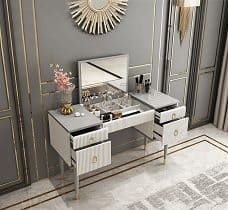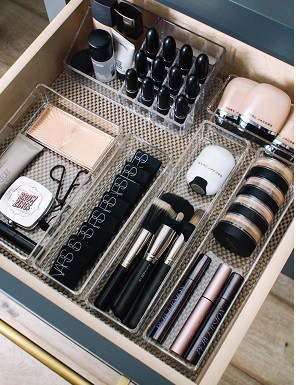
Cosmetics
For most women, a specialized vanity table equipped with storage drawers, a seating bench, and a mirror with proper lighting is a fantasy place to apply facial cosmetics, which are any products applied to the face: makeup, lotions, and makeup applicators (e.g., brushes, sponges). Many of us resort to basic bathroom accommodations to put ourselves together every morning, but there are ways to contain makeup in specialized organizers that can add a bit of glamour to a bathroom. Fortunately, many makeup organizers are decorative and functional enough to dress up any space. Then there are those that can be concealed in a cabinet or drawer. Decide which type of organizer suits your space and tastes. The following are various organizers you can use to store your cosmetics and related accessories in a bathroom.

Countertop Cosmetic Organizers
These organizers can sit on any open space (counters or shelves) and in cabinets and closets. Most are designed with tiered levels of storage to compartmentalize several small groups of cosmetics, such as compacts, mascara, or lipstick. It’s important to think about which organizer best suits your belongings because you want the compartment sizes to fit the types and number of cosmetics you possess.
Popular translucent acrylic cosmetic organizers make stored articles easily identifiable. These organizers are attractive for the countertop. You can find such organizers with drawers and individual compartments designed specifically for particular items such as lipstick or nail polish. Another efficient countertop organizer is the tiered 360-degree rotating cosmetic organizer. This organizer can fit in corner spaces and offers great access to cosmetics.
For those who don’t like the look of open storage, there are organizers that conceal the entire contents inside a countertop cabinet similar in design to many jewelry boxes. These organizers have doors that open to many small drawer compartments.

In-Drawer Organizers
Most in-drawer cosmetic organizers are compartmentalized trays found in stores that sell bathroom or home office organizational items. Modular drawer containers and kits designed to compartmentalize drawers are several inches tall and fit in deeper drawers to hold larger cosmetic items.

Freestanding and Portable Cosmetics Organizers
Tiny or congested bathroom spaces benefit from wheeled or handled cosmetic organizers that are easy to transport. Wheeled, tiered cart organizers with pullout drawers can also hold cosmetics. These are convenient to roll into a closet for storage in between uses.
There are also portable, handled cosmetic totes and caddy organizers that can move to a counter when needed and then nicely tuck away in a deep drawer, cabinet shelf, cart, or closet when not in use. There are clever freestanding changing mirrors that open into a storage cabinet for small items and are great if your bathroom can spare just a little floor space.

Downsizing Cosmetics
Many people don’t realize that makeup has a shelf life or are misinformed about actual product expiration dates. Most cosmetics have a period-after-opening (PAO) symbol on the label, which is marked by a photo of an opened container along with the number of months it can keep once opened. For example, “6M” means six months. Shelf life is also determined by how a product is stored and the type of packaging used. Makeup can go bad and form bacteria, which could damage the skin. Help prevent bacteria
formation by applying makeup with clean hands and makeup applicators. On a monthly basis, deep clean all makeup applicators, especially heavily soiled brushes used for liquid or cream-based makeup. Treat them with a specific brush cleaner or make your own with a degreasing liquid soap, a little olive oil (which actually removes oil), and a new sponge. Makeup brush cleansing wipes can be used in between deep cleanings. Depending on the quality of the sponge and how it’s maintained (daily rinsing is recommended), most blending sponges should be discarded after three months. Makeup is usually marked with a manufacturer’s expiration date, but once opened, this date changes. The following are general expiration dates for various types of opened cosmetics. However, these dates vary by specific product ingredients and packaging.
Natural Products
Any product made without preservatives will have a short shelf life. It’s best to contact the product’s company for expiration information. Cream Concealers, Liquid Foundations, Eyeliners, and Mascaras All these products are water-based, so they’re prone to bacteria formation after opening. Eyeliner and mascara have the shortest lifespans: only four to six months. Therefore, consider buying inexpensive eye makeup and replacing it often, because bacteria can lead to eye infections. Foundations can last up to one year when properly stored. Don’t place a used sponge on the rim of a liquid makeup bottle to dispense the product because a bacteria risk is present.
Face Powders, Blush/Bronzers, and Eye Shadows Dry textures like powder are less likely to develop bacteria. Keep pressed powder, blush/bronzers, and eye shadow compacts clean by gently wiping off a fine top layer with a dry white paper towel once a month. If well-sealed, these products can keep for up to two years.
Brow and Lip Pencils
Keep makeup pencils well sharpened, and wipe them down with makeup wipes regularly. Brow pencils last a few years and lip pencils for approximately one year.
Lipsticks and Lip Gloss
Lip gloss is prone to discoloration and will thicken to the point where it goes on too clumpy, which is a sure sign to discard it. Lipstick and lip balm sticks can be cleaned with a makeup wipe. Lipstick can last up to two years and lip balm one year when properly resealed.
Cosmetics Organization Tips
- Organize cosmetics by grouping them by like items,
such as bronzers, eye shadows, and mascaras. - Discard anything missing a lid or with a cracked case, because of air exposure degrades makeup.
- Get rid of pressed powders that have cracked because they’ll inevitably break down and create a big mess.
- Toss any expired makeup or anything that has clumped, separated, dried out, discolored, or changed texture.
- Sharpen all pencils.
- With a clean, damp white paper towel or makeup wipe, clean all cosmetic containers thoroughly and carefully around the rim without making contact with the actual product.
- Invest in makeup expiration stickers, or use any small blank sticker and start recording the date a product is opened. Keep the stickers with all the unopened makeup outside of the cosmetics organizer.
- The amount of makeup to keep is such a personal decision; however, it’s best to keep only what you regularly use. Makeup that has not been touched in a few months will most likely not be used. Due to the short shelf lives, this makeup should be discarded.
